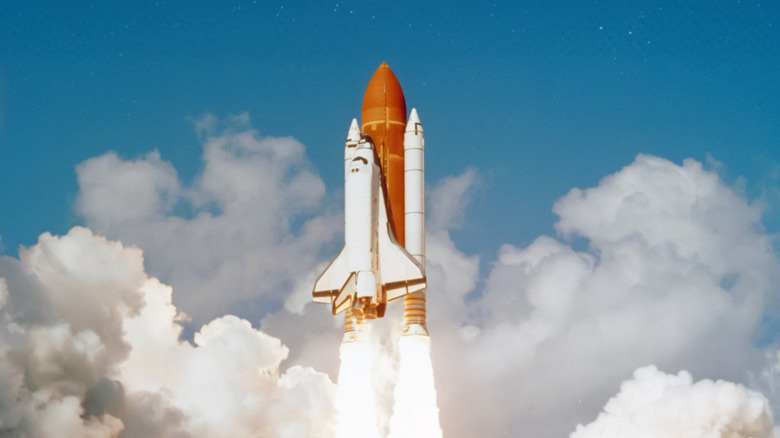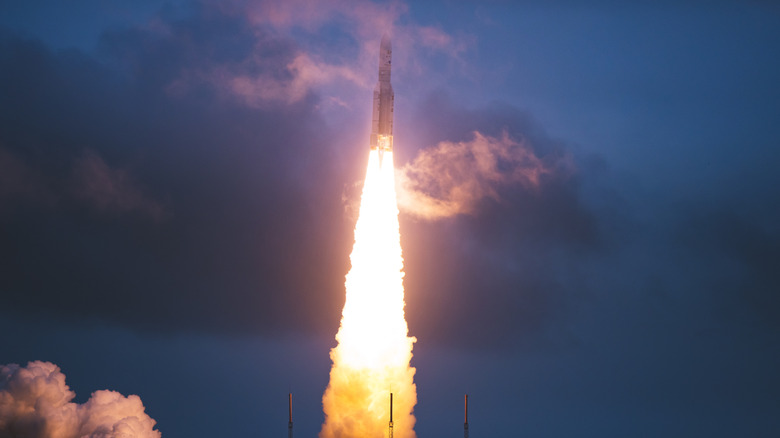Why The US Launches Spaceships From Both Florida And California
For decades, space travel has endured as one of humanity's most remarkable achievements. To launch a shuttle, be it full of human beings or without life of any kind, into space for observation, exploration, or any other purpose, is a concept only dreamed of throughout most of history. Of course, even after years of advancement, there's more to going to space than just constructing a rocket and taking off. NASA has explained the importance of considering the launch window, and spaceships don't take off from just anywhere. In the United States, a couple locations have primarily been chosen for this task.
Currently, both Cape Canaveral Space Force Station in Florida and Vandenberg Space Force Base in California are NASA's main launch locations, but why? As it turns out, these spots have been chosen for specific launches based on the destination of the shuttle going up. Cape Canaveral is ideal for launches seeking to make an equatorial orbit, since Florida is close to the equator. If the planned orbit is supposed to move from west to east, Cape Canaveral is the place as well. As for Vandenberg, it's good for north to south and those where the orbit is intended for somewhere in the polar regions.
Thanks to their mission-specific accommodations, Florida and California have become the most ideal places for space ship launches in the US. With that said, they're not the only locations to host NASA lift-offs.
Other areas have set the stage for US space travel
Thanks to their coastal locations and hosting of some of the most notable NASA launches of all time, the launch facilities in Florida and California are two of the organization's most famous locations. With that said, they're far from the only ones, even to this day. Case in point, the Wallops Flight Facility, located on Wallops Island, Virginia, which has been around since 1945 — years before the Cape Canaveral site first opened its doors. With focuses on aerospace travel, rocket testing, satellite tracking, and more, Wallops Flight Facility is a governmental and commercial powerhouse. It's all advertised as low-cost, too, which is major considering the costs involved with space travel.
Another, less well-known site is the Reagan Test Site in the Kwajalein Atoll, Marshall Islands. With a history dating back to the 1960s, this location focuses on defense in the form of long-range missile testing, as well as space domain awareness. Meanwhile, a more recent addition to the rocket launch game is the Pacific Spaceport Complex on Kodiak Island, Alaska. Though not a NASA entity, instead owned and operated by the Alaska Aerospace Corporation, the branch has utilized it for launches since its founding in the late 1990s.
This only speaks to spaceports utilized by the United States. As space exploration has become a priority for other nations, more strategically-placed launch sites have sprung up around the world.
The United States isn't the only nation with specifically-placed spaceports
Space travel is far from an America-only endeavor. Famously, the U.S. found itself at odds with the Soviet Union during the 1960s during the fabled Space Race. During this period, Russia established launch sites of its own, carefully picking their locations. The Baikonur Cosmodrome was built in the 1950s near Tyuratam, Kazakhstan. It was named after a village roughly 200 miles away to throw off prying eyes in the US. It's best known for the Sputnik launch in 1957. The Plesetsk Cosmodrome was established around the same time in remote Northern Russia. Intercontinental ballistic missiles launched from there could theoretically reach the U.S., hence why this region was chosen. Today, it's used for missile testing and space launches alike.
Moving away from Russia, we find the Guiana Space Center in French Guiana, South America. This launch site is used primarily by the European Space Agency and is especially efficient due to its location. Its proximity to the equator makes launches more fuel-efficient thanks to the intensity of the Earth's rotation, which generates a slingshot effect. China has become a noteworthy player in the space game, with the Jiuquan Satellite Launch Center being arguably its most relevant of its three spaceports. It hosted the nation's first space launch in 1970, being constructed in the middle of the Gobi Desert for the sake of isolation and security.
Even as space-faring technology has evolved, the odds of being crushed by a rocket has spurred conversation, and more launch sites have sprung up, many of the dated ones remain in use. It stands to reason that the historical and strategic significance of NASA's Florida and California sites will sustain their prominence for years to come.


